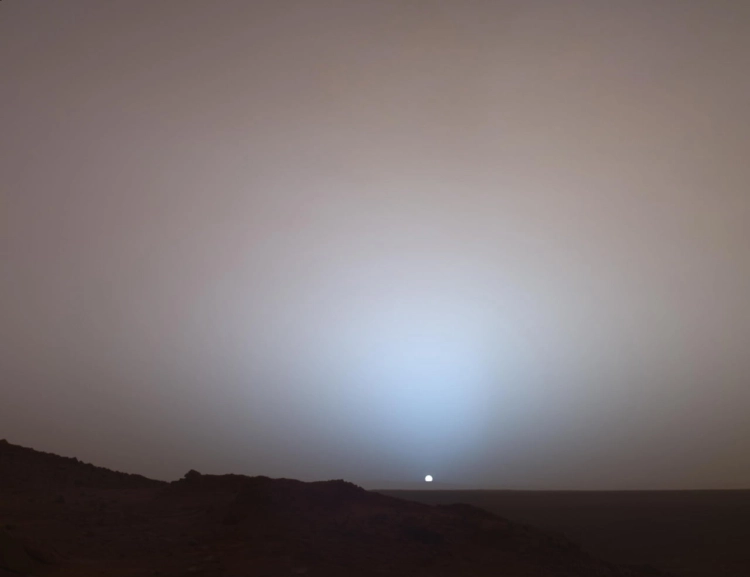

The quick answer: Sunlight scatters as it passes through Earth's atmosphere, and blue light, which has a shorter wavelength, scatters more than other colors. This scattering of light is called Rayleigh scattering, and it's why we see the sky as blue.
The sun emits white light, which is actually a mix of all the colors of the rainbow. When this light reaches Earth, it encounters the atmosphere, filled with tiny gas molecules and particles. As light hits these particles, it scatters in different directions, a process known as Rayleigh scattering.
Why blue? The reason we see blue has to do with the wavelength of light. Blue light has a shorter wavelength than colors like red or yellow. Because of this, it gets scattered in all directions much more easily. Meanwhile, colors with longer wavelengths, like red and orange, pass through the atmosphere with less scattering. This makes blue light dominate the sky.
You might wonder, if violet light has an even shorter wavelength than blue, why isn’t the sky violet? There are two key reasons for this. First, while violet light does get scattered even more than blue light, there’s simply less violet light in the sunlight that reaches us. Second, our eyes are much more sensitive to blue light than violet, so we perceive the sky as blue. Also, some of the violet light gets absorbed by the upper atmosphere, reducing how much reaches our eyes.
Imagine it like this: Blue light, like a small pebble tossed into a pond, creates ripples that spread out in all directions. Red light, like a larger rock, makes fewer ripples and passes through the atmosphere with less scattering. That’s why blue light dominates the sky during the day.
The color of the sky changes depending on where the sun is in the sky. When the sun is high overhead, the light has to travel through a shorter distance of atmosphere to reach us. In this case, much of the sunlight reaches us directly, and we still see a blue sky, but it's brighter, and the scattered blue light blends with the rest of the sunlight.
However, when the sun is near the horizon, at sunrise or sunset, the light has to travel through more of the atmosphere. As it does, more blue and violet light is scattered out of our line of sight. This leaves behind the longer wavelengths, like red, orange, and yellow, giving us those warm, beautiful colors we see during sunrise and sunset.
To understand this better, let’s take a moment to talk about light. Visible light is a form of electromagnetic radiation that our eyes can detect. It has wavelengths ranging from about 380 nanometers (violet) to 750 nanometers (red). White light, like the light from the sun, contains all the colors in this visible spectrum.
While light travels through space, it moves in waves, and the wavelength determines the color we see. Shorter wavelengths, like blue and violet, scatter more, while longer wavelengths, like red and yellow, scatter less. This is why blue light scatters throughout the sky, while red light is more prominent during sunrise and sunset.
As light travels through space for long distances, its wavelength stretches, moving into the infrared spectrum. Infrared light has wavelengths that are longer than visible light, which is why we can't see it with the naked eye. Telescopes like the James Webb Space Telescope and Hubble use infrared technology to detect this "older" light from distant parts of the universe. The images we see from these telescopes are often processed and filtered to bring the light back into the visible spectrum so that we can see them.
Not all skies are blue. The color of the sky on other planets depends on their atmospheres.
The Moon: If you look at photos from the moon landings, you’ll notice the sky is black. This is because the Moon has almost no atmosphere to scatter the sunlight.
Mars: Mars has a thin atmosphere filled with iron-rich dust, which scatters light differently. During the day, the sky looks reddish-brown, but near sunrise and sunset, the area around the sun appears blue due to the way light scatters through the dust.
Venus: Venus, with its thick atmosphere of carbon dioxide and clouds of sulfuric acid, has an orange sky. The thick atmosphere creates intense scattering, giving it a hazy, orangish hue.

One can only imagine what colors other planets, with different atmospheres, might paint across their skies. From blue to red and everything in between, the universe is filled with breathtaking views waiting to be discovered.
The color of the sky is a beautiful result of how sunlight interacts with the atmosphere. Here on Earth, Rayleigh scattering causes the sky to appear blue during the day, and as the sun sets, we get stunning reds, oranges, and yellows. On other planets, different atmospheric compositions give us a variety of sky colors. It’s a reminder of the fascinating science behind the everyday wonders of our world and the universe beyond.